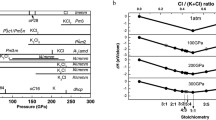Abstract
Ternary chlorides are stable if they can be formed from each pair of the other compounds in a system with a gain in energy. Especially, the energy of formation from the two adjacent compounds, the energy of synproportionation must be negative. At 0 K this condition is fulfilled, if (lattice) enthalpy is won. At higher temperature also theT·ΔS-term of the Gibbs-Helmholtz-equation can be of significance: a loss in ΔH must be compensated by a gain inT·ΔS, if a (high-temperature) compound shall exist.
This conception was proved experimentally on systems ACl/MCl2 and ACl/LnCl3(Ln=Lanthanides). By DTA and X-ray powder patterns the phase diagrams of the pseudobinary systems were elucidated, to yield the stoichiometry and structures of the existing compounds. By solution calorimetry the formation enthalpies at room temperature from the binary parent-compounds were determined. Measurements with a galvanic cell for solid electrolytes at temperatures higher than ∼ 300 °C yield the free enthalpies and entropies of synproportionation.
The main result of these measurements is, that compounds with isolated coordination polyhedra (K2CoCl4=tetrahedra; Rb3LaCl6=octahedra) can have a sufficiently high gain in entropy to be stable at temperatures > 0 K.
Zusammenfassung
Ternäre Chloride sind stabil, wenn sie sich aus allen Paaren der restlichen in einem System existierenden Verbindungen unter Energiegewinn darstellen lassen. Insbesondere muß die Bildungsenergie aus den beiden Nachbarverbindungen, die Synproportionierungsenergie, netativ sein. Bei 0 K ist diese Bedingung erfüllt, wenn dabei (Gitter-) Enthalpie gewonnen wird. Bei höheren Temperaturen kann auch derT·ΔS-Term der Gibbs-Helmholtz-Gleichung ausschlaggebend werden: ein Verlust an ΔH muß durch einen genügend großen Gewinn anT·ΔS kompensiert werden, damit eine (Hochtemperatur-) Verbindung existieren kann.
Dieses Konzept wurde experimentell an Systemen ACl/MCl2 und ACl/LnCl3 (Ln=Lanthanoid) bewiesen. Durch DTA und Röntgenpulveraufnahmen wurden die Phasendiagramme der pseudobinären Systeme erstellt, um Zusammensetzung und Strukturen der existierenden Verbindungen zu ermitteln. Mittels Lösungskalorimetrie wurden die Bildungsenthalpien bei Raumtemperaturen aus den binären Ausgangsverbindungen gemessen. Messungen mit einer galvanischen Zelle für Festelektrolyte bei Temperaturen >300 °C lieferten die freien Enthalpien und Entropien für die Synproportionierungsreak-tionen. Als wichtigstes Resultat ergab sich, daß Verbindungen mit isolierten Koordinationspolyedern (K2CoCl4=Tetraeder; Rb3LaCl6=Oktaeder) einen so großen Entropiegewinn aufweisen, daß sie bei hohen Temperaturen stabil sein können.
РЕЗЮМЕ
Третичные хлориды яв ляются стабильными соединениями, если их образование их каждой пары других соединений сопровож дается выигрышом энергии. Эн ергия образования из двух смежных соеди нений должна быть отр ицательной. При О К это условие вып олняется, если достигнут избыт ок (решеточной) энталь пии. При более высокой темпер атуре в уравнении Гиббса-Гельмгольца з начение приобретает членT·ΔS таким образом, что пот еря в ΔH должна компенсироваться вы игрышем вT·ΔS при нали чии высокотемпературно го соединения. Эта кон цепция экспериментально до казана на системах АС l/МСl2 и ACl/LnCl3, где Ln — лантаноиды. С помощью ДТА и рентге ноструктурного анал иза были объяснены фазовые ди аграммы псевдобинар ных систем с получением п ри этом стехиометрии и структуры существующих соедин ении. С помощью калориметр ических измерений ра створов были определены их энталь пии образования из двойных родственн ых соединений. Измере ния твердых электролитов с гальв анической ячейкой при температ урах выше 300° дали возм ожность определить свободны е энтальпии и энтропии синпропорц ионирования. Главным результатом проведенных измерен ий является тот факт, что соединения с изолированным коорд инационным полиэдром (К2СоСl4 — тет раэдр, RbLaCl6 — октаэдр) могут име ть достаточный избыт ок энтропии, чтобы быть с табильными при температурах выше О К.
Similar content being viewed by others
References
H. J. Seifert and U. Langenbach, Z. anorg. allg. Chem., 368 (1969) 36.
G. Thiel and H. J. Seifert, Thermochim. Acta, 22 (1978) 363.
H. J. Seifert, G. Thiel and G. Flohr, Z. anorg. allg. Chem., 436 (1977) 237+244.
H. J. Seifert and G. Thiel, Thermochim. Acta, 100 (1986) 81.
H. J. Seifert, H. Fink, G. Thiel and J. Uebach, Z. anorg. allg. Chem., 520 (1985) 151.
H. J. Seifert, H. Fink and G. Thiel, J. Less-Common Metals. 110 (1985) 139.
Author information
Authors and Affiliations
Additional information
Support by the Deutsche Forschungsgemeinschaft and Fonds der Chemischen Industry is gratefully acknowledged.
Rights and permissions
About this article
Cite this article
Seifert, H.J. Why do ternary compounds exist? — Thermoanalytical investigations on binary systems of metal chlorides. Journal of Thermal Analysis 33, 147–155 (1988). https://doi.org/10.1007/BF01914594
Issue Date:
DOI: https://doi.org/10.1007/BF01914594




